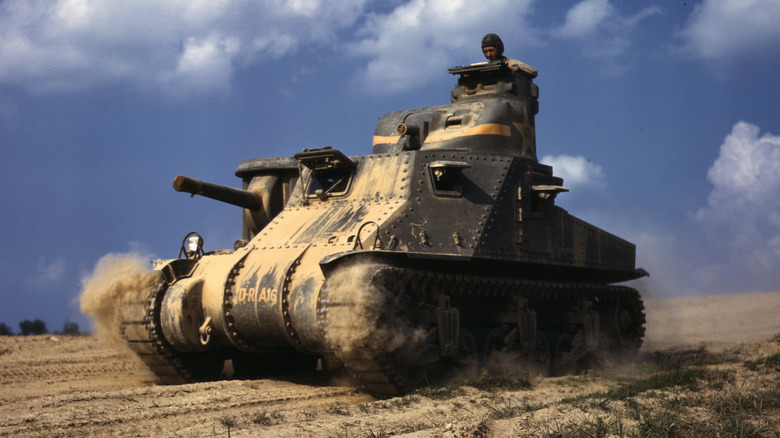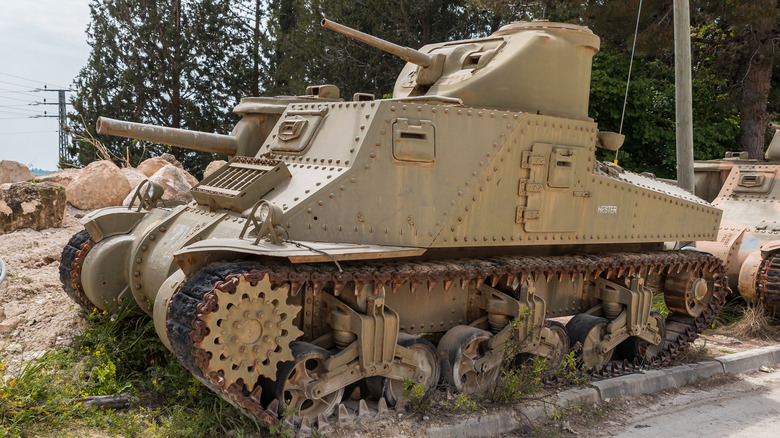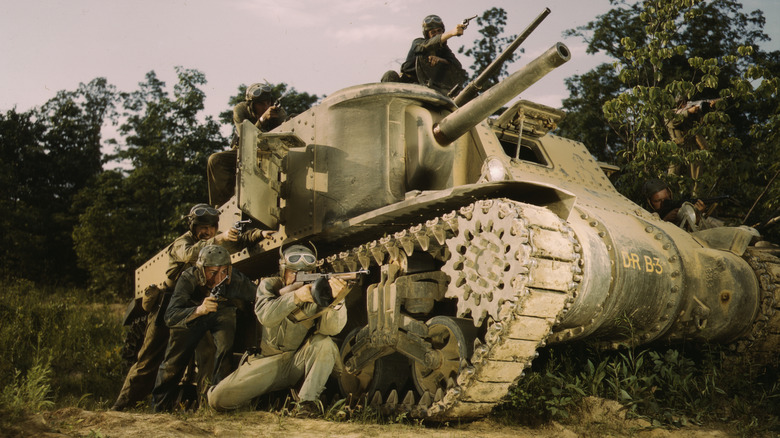The Biggest Strengths And Weaknesses Of The M3 Lee/Grant Military Tank
The United States fielded thousands of tanks during World War II, and while most people know of the M4 Sherman, another tank preceded it. The M3 Lee (called the Grant in the U.K.) was designed to function as the Army's primary medium tank across the entire theater of war until the M4 rolled off assembly lines. The tank entered development in 1940, and by late 1941, it began combat operations in Europe.
The M3's design made it useful to both U.S. and U.K. armored personnel, and by the end of its use in combat, in under two years, more than 6,250 were manufactured. The M3 wasn't as formidable as its successor, but it boasted several advancements that made it a reliable tank for European operations. Comparatively, the M3 outgunned the German Panzer IV, which entered service the previous decade. When the Panzer III and IVs received increased firepower upgrades, the M3 withdrew to make room for the far superior M4.
Despite its relatively short lifespan in military combat, the M3 has a history of support in the early days of U.S. involvement in the European theater of war. While the U.S. withdrew them from Europe, the U.K. continued operating them in the Pacific. Close to a thousand were provided to the Soviet Union between 1941 and 1943, so it has a fascinating history in and out of warfare during WWII.
The M3 brought unequaled armored firepower to Europe
The M3 entered service with the U.S., knowing it was a short-term solution to an ongoing problem. While a much larger and more capable tank was still being developed, the U.S. needed something to help support its infantry while opposing enemy armor, so the M3 boasted a 75mm gun capable of firing high explosive, armor-piercing munitions. A secondary .37mm cannon sat atop the tank, and two Browning M1919 7.62 mm machine guns were emplaced in fixed positions.
The M3 was a medium tank, but a 75mm gun made it pack a significant punch. While it had a short U.S. operational lifespan of only 16 months, the U.S. and U.K. manufactured several variants, including larger howitzers built upon the tank's chassis; others boasted more robust engines and some models aided in tank recovery and minesweeping. This made the M3 a versatile platform that could operate in multiple environments while providing a variety of functions.
In terms of combat effectiveness and range, the M3 could fire up to a maximum effective range of 2,700 meters (approximately 1.67 miles). The tank carried 46 75mm rounds, 178 for a 37mm cannon mounted in a fully traversable turret atop the tank, and 9,200 rounds for the machine guns. It also boasted an aircraft-based high-octane power plant capable of reaching a maximum speed of 26 mph on the road and 16 mph in off-road conditions.
The M3's height was a major issue with tankers
Modern tanks are designed to have as low a profile as possible. Modern armor can also be placed in a hull-down position, keeping its turrets above ground, which maximizes lethality while protecting the tank and everyone inside. The M3 had no such capability as it was designed with two distinct limitations that made it way too tall.
First, the main gun isn't centrally placed on a rotating turret and instead was situated in a traversable sponson on the right side of the tank. This limitation made it more difficult to target and fire upon enemies not directly in front of the tank. The addition of a machine gun atop the vehicle further increased its silhouette, making it easier to identify and fire upon from greater distances, which isn't ideal for a tank. The initial configuration of the M3 had it standing ten feet, seven inches, which is way too high — for comparison, the modern M1 Abrams is 7.79 feet tall.
Other issues with the M3 included its use of riveted armor, which could burst inwards when hit. Shrapnel from this type of impact could bounce around inside the tank, tearing apart anyone inside. This happened when a rivet took a direct hit, shearing it from the armor and transforming a protective armor into a deadly hazard. While these limitations made the M3 a less-than-ideal tank for operations during WWII, it served a vital purpose, filling the gap until the more advanced M4 could be fielded in 1942.


